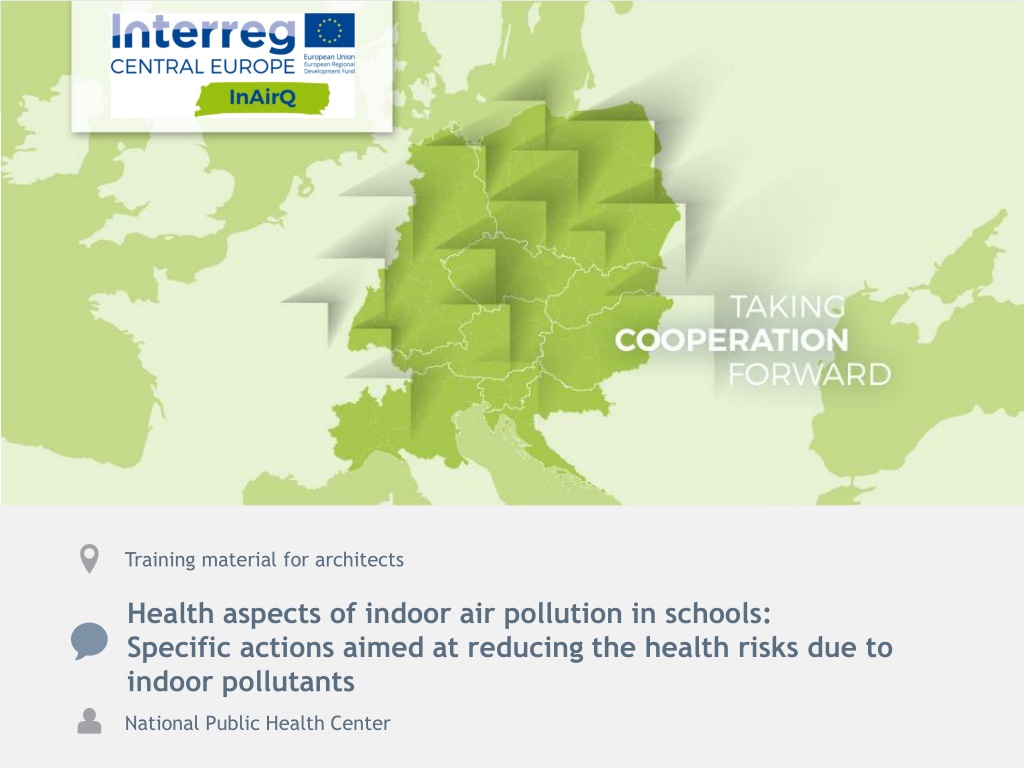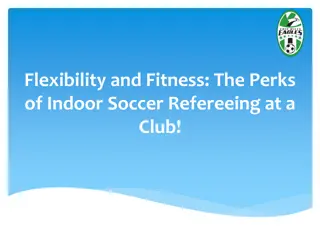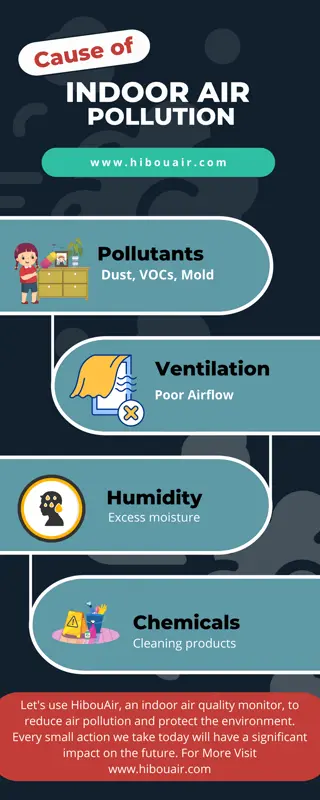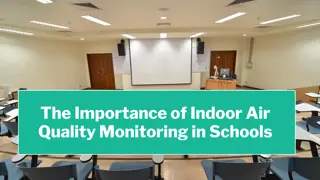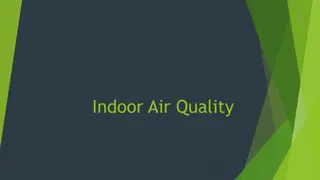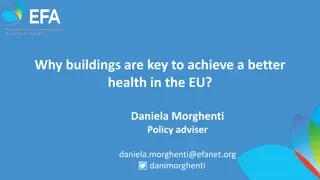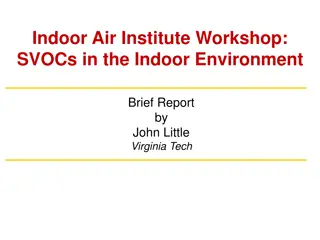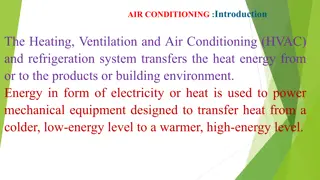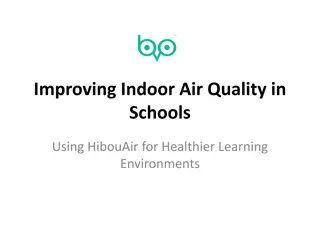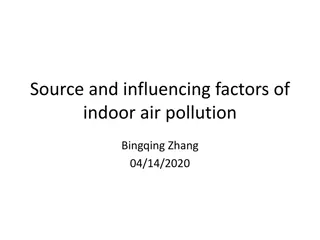Understanding Indoor Air Quality in Schools
Exploring the importance of indoor air quality (IAQ) in schools, this training material for architects addresses factors influencing IAQ, primary sources of contaminants, health impacts of indoor air pollution, and specific actions to reduce health risks. Children's health and environment action plans for Europe prioritize reducing respiratory diseases linked to indoor air pollution. Focus is on creating a healthy indoor environment for children to thrive.
Download Presentation

Please find below an Image/Link to download the presentation.
The content on the website is provided AS IS for your information and personal use only. It may not be sold, licensed, or shared on other websites without obtaining consent from the author. Download presentation by click this link. If you encounter any issues during the download, it is possible that the publisher has removed the file from their server.
E N D
Presentation Transcript
Training material for architects Health aspects of indoor air pollution in schools: Specific actions aimed at reducing the health risks due to indoor pollutants 1 TAKING COOPERATION FORWARD National Public Health Center
Outline Indoor Air Quality Factors influencing IAQ Primary sources of IAQ contaminants - Outdoor sources - Indoor sources Overview of air pollutants Health impacts of indoor air pollution Contribution of indoor air pollution to the disease burden Sick Building Syndrome Indoor Environmental Quality (IEQ) Health impacts of climate change 2 TAKING COOPERATION FORWARD
Why IAQ issues important in schools? Children spend 90% of their time indoors (classrooms, homes, vehicles) Studies have indicated that indoor air often contain higher levels of contaminants than outdoor air. In Hungary there are 3585 primary schools with 735 thousands pupils. This is almost 10% of the population! Number of teachers in primary schools: 78 thousand (in 2018). Focus on Children s Health and healthy environmental issues according to the European Environment and Health Process (WHO/Euro, UN ECE) has high priority. 3 TAKING COOPERATION FORWARD
Childrens Health and Environment Action Plan for Europe Children s health and healthy environmental issues according to the European Environment and Health Process (WHO/Euro, UN/ECE) has gained a high priority. In 2004, the Fourth Ministerial Conference on Environment and Health adopted the Children s Health and Environment Action Plan for Europe, which includes four regional priority goals to reduce the burden of environment- related diseases in children (CEHAPE). One of the goals (Regional Priority Goal, RPG III) aims to prevent and reduce respiratory diseases due to outdoor and indoor air pollution, thereby contributing to a reduction in the frequency of asthmatic attacks, and to ensure that children can live in an environment with clean air. Source: http://www.euro.who.int/__data/assets/pdf_file/0006/78639/E83338.pdf 4 TAKING COOPERATION FORWARD
Indoor Air Quality (IAQ) Indoor space: any closed area surrounded by boundary elements (including the indoor space of vehicles) Indoor Air Quality refers to the quality of the air inside buildings as represented by concentrations of pollutants and thermal (temperature and relative humidity) conditions that affect the health, comfort, and performance of people staying inside. Indoor air pollution does not include technology-related air pollution in the workplace! 5 TAKING COOPERATION FORWARD
Why did IAQ come into focus? Reduction of outdoor air pollution Changing construction practices - construction material (concrete) air permeability - widespread use of plastics and adhesives Prefabricated buildings lower ceiling height New heating methods Energy conservation aspects thermal insulation Different habits in the usage of indoor spaces Time spent indoors: 80-90% 6 TAKING COOPERATION FORWARD
What is the significance of IAQ in schools? Growing children with developing their physiological capability are very sensitive to hazardous chemicals. Exposure to poor IAQ in school can interfere with a pupil s ability to learn. Asthma, headaches, nausea, drowsiness, and dizziness can be troubling. Toxic chemicals can cause not only acute symptoms like irritation, but long lasting adverse health damage. Low level of comfort leads to dissatisfaction. 7 TAKING COOPERATION FORWARD
Factors influencing IAQ Outdoor air quality Extent of air exchange The binding capacity of indoor surfaces Indoor pollution sources (people, animals, furniture, building- and covering materials etc.) Indoor Air = Outdoor Air + f (Building) + (Activities) 8 TAKING COOPERATION FORWARD
Outdoor sources of pollution Traffic (proximity of busyroads, petrol vs. diesel, cars vs. trucks) Power plants Other industrial plants Pollution from constructions Waste deposit sites Agricultural activity (e.g. spraying pesticides) Architectural factors that influence the pollutants infiltration from outdoor Orientation Storey level Classrooms facing the street or the yard Role of vegetation Parking places, smoking area near the windows of the classrooms 9 TAKING COOPERATION FORWARD
Indoor sources of air pollution in classrooms Dust Construction and insulating materials Surface materials (wall covering, carpets, blinds, curtains) Furnishings Evaporation of volatile chemicals from new materials Paints Waxes, repellents Glues and resins Solvents Photocopiers, inks Cleaning/disinfecting products Biocides Personal care products People (exhaled air, smoking?) Pets, rodents, insects Mould (from moisture) Secondary material emissions: e.g., due to moisture ozone from laser printers outdoors and nitrogen oxides reacting with VOCs cleaning materials can react with surfaces 10 TAKING COOPERATION FORWARD
How common are IAQ problems? O r g a n i z a t i o n C h a r t T i t l e buildings without known problems 70-80% b u i l d i n g s w k n o w n p r o b l e m 2 0 - 3 0 % i t h s undetected problems 10-20% buildings without real problems 50-70% b u i l d i n g r e l a t e d i l l n e s s ( B 5 - 1 0 % s i c k b u i l d i n g s y n d r o m 1 0 - 2 5 % R I ) e ( S B S ) John Oudyk: Doing Something about Indoor Air Quality. Occupational Health Clinics for Ontario Workers Inc., 2014 11 TAKING COOPERATION FORWARD
Relative importance of indoor air pollutants (Stolwijk)* 12 TAKING COOPERATION FORWARD
The ratio of pollutant concentrations measured outdoors and in the classrooms 4.31 4.5 4 3.5 3 Indoor/Outdoor ratio 2.5 1.98 1.85 2 1.53 1.5 1.11 0.91 1 0.7 0.5 0 NO2 PM10 Benzene Ethyl-benzene Xylenes Toluene Formaldehyde 13 TAKING COOPERATION FORWARD
Contaminants generated by people staying inside (biocontaminants) Fresh air contains 21.0% (v/v) O2 Exhaled air contains 17.0% (v/v) O2 and 83.0 % (v/v) CO2 An adult emits 45 g sweat / hour An adult produces 300 British Thermal Unit (BTU) of heat /hour [300 calories]. 14 TAKING COOPERATION FORWARD
Particle Emission Based Upon Activity Activity Particles Standing/Sitting (no movement) 100,000 Light movement 500,000 Body & arm movement 1,000,000 Changing Positions 2,500,000 Slow walking 5,000,000 Average walking 7,500,000 Gymnastics >15 million 15 TAKING COOPERATION FORWARD
Particles Produced by Infected Persons National Air Filtration Association; 2006 Rev. 2 16 TAKING COOPERATION FORWARD
Microbial Indoor Air Pollution mould bacteria, viruses pet hair, skin flakes, faeces, urine insects (cockroach faeces, dust mites, etc.) pollen Outdoor sources: mould, pollen in outdoor air Indoor sources - major concern: - humidifiers and stagnant waters - moist surfaces and materials - vapour from showering - air conditioning - upholstered furniture and carpets - animals (the allergens can be present months after the removal of the source) - infected people 17 TAKING COOPERATION FORWARD
Causes of dampness/mould in the buildings Rising dampness The capillary-like absorption of groundwater into the structural elements of the building (bad insulation) Penetrating dampness leaking, rain, melted snow (through the roof, walls or joints) Condensation Excessive vapour production or inadequate ventilation Inadequate heating Cold surfaces 18 TAKING COOPERATION FORWARD
Health consequences of dampness/mould in the buildings Increased risk of - respiratory symptoms - respiratory infections - exacerbation of asthma - development of asthma - allergic rhinitis - allergic alveolitis - hypersensitivity pnemonitis N.B.: Atopic and allergic people are particularly susceptible! WHO Indoor Air Quality Guidelines on Dampness and Mould (2009) As the relationships between dampness, microbial exposure and health effects can not be quantified precisely, no quantitative, health-based guidline values or thresholds can be recommended for acceptable levels of microorganism contamination. Instead, it is recommended that dampness and mould-related problems be prevented. When they occur, they should be remediated because they increase the risk of hazardous exposure to microbes and chemicals. 19 TAKING COOPERATION FORWARD
An overview of the chemical pollutants 20 TAKING COOPERATION FORWARD
Combustion products Combustion products: Carbon monoxide (CO) Nitrogen dioxide (NO2) Sulphur dioxide (SO2) Nitrogen oxides (NOx) Particulates (PM) PAH compounds Sources: Ambient air (traffic, power plants, industry) Heating, stoves and fireplaces Environmental tobacco smoke (ETS) Garages Parking lots nearby classroom windows Candles, sparklers and incenses Mosquito coils 21 TAKING COOPERATION FORWARD
Nitrogen-dioxide (NO2) I/O ratio ~ 0.8 Health effects: Asthmatics are especially sensitive (!) Increased bronchial reactivity Reduced respiratory function Increased respiratory morbidity Reduced immunological protection Middle ear, nose-, ear-, pharynx inflammation Increases the allergenic effect of allergens (e.g. Food allergy!) Eczema Increased blood coagulation in adults Limit values: WHO: indoor 1 hour: 200 g/m3 annual: 40 g/m3 22 TAKING COOPERATION FORWARD
Carbon monoxide (CO) I/O ratio ~ 1.0 It is caused by incomplete combustion. Sources: Heating and cooking devices ETS Running car engines in the garage! Car traffic Other outdoor CO sources (power plant, incinerator, industrial pollution) CO binds 250 times stronger to haemoglobin than O2. Foetal Hb also has a stronger affinity to CO. CO causes tissue hypoxia. 23 TAKING COOPERATION FORWARD
Carbon monoxide (CO) Acute symptoms: Headache, vertigo, tiredness, heavy breathing Nausea, vomiting Irritability Drowsiness, confusion, desorientation Loss of consciousness, coma Death Increasing COHb concentration Chronic exposure: Ischemic heart disease, myocardiac failure, AMI retardation in fetal development, reduced birthweight, congenital malformation Increased cardiovascular and total mortality Asthma, sinusitis, pneumonia 24 TAKING COOPERATION FORWARD
Carbon monoxide (CO) Taking sensitive populations into account (!) WHO Guideline: 15 min.: 100mg/m3 1 hour: 35 mg/m3 8 hours: 10 mg/m3 24 hours: 7 mg/m3 (INDEX project: 30 mg/m3) 25 TAKING COOPERATION FORWARD
Ozone At ground level ozone is not emitted directly, but it is created by chemical reactions between NOX and VOCs in the presence of sunlight and heat. OZONIZERS as air purifiers Ozone is harmful to health Chest pain, coughing, throat irritation, airway inflammation, lung damage The air purifying effect of ozone is ineffective in concentrations under the limit values WHO AQG for Europe (2nd ed.) 120 g/m3 (8 hours), It is used in high concentrations to disinfect, deodor, or for chemical decontamination of spaces not intended for human staying. 26 TAKING COOPERATION FORWARD
Pollutants released indoors Formaldehyde Other Volatile Organic Compounds Phthalates, polybrominated flame retardants, per- and polyfluorinated chemicals Vinyl chloride Trichloroethylene, tetrachloroethylene, ammonia Terpenes (limonene, alpha-pinene) Phenol Naphthalene Asbestos 27 TAKING COOPERATION FORWARD
VOCs formaldehyde, organic solvents (benzene, xylenes, ethylbenzene, toluene, carbon tetrachloride, styrene), methylene, perchloroethylene, vinylchloride, benzene, toluene, xylene, aniline, terpenes (limonene, alpha-pinene), etc. Concentrations of many VOCs are consistently higher indoors (up to ten times higher) than outdoors. Sources: paints, paint strippers and other solvents wood products (formaldehyde) varnishing aerosol sprays air fresheners, deodors, hair sprays cleansers and disinfectants pesticide building materials and furnishings office equipment (copiers and printers glues and adhesives, permanent markers, highlighters, correction fluids Health effects: eye, nose and throat irritation headaches, fatigue, dizziness, nausea damage to liver, kidney and central nervous system some organics are suspected or known to cause cancer 28 TAKING COOPERATION FORWARD
Formaldehyde Sources: Furniture Wood products Insulation (urea formaldehyde insulators - UFFI) Disinfectant preservatives (paints, varnishes, parquets, wallpapers) Laminated and extruded plastic products (urea- and phenol-formaldehyde resins) Polymers (polyacetates, melamine-resins) Traffic (exhaust emissions) Cigarette smoke Acute health effects of exposure: Mucous membrane irritation (lacrimation, sneezing, throatache, increased expectoration) Inhibits ciliary activity Skin irritation (rash, itching) Allergenic, sensitizing effect Sinusitis, headache, nausea, insomnia Weak mutagenic effect, but synergism (UV, rtg) Chronic health effects of exposure: Chronic rhinitis, bronchitis Bronchial asthma Allergy Carcinogen (IARC Group 1) Emission increases with temperature and humidity! 29 TAKING COOPERATION FORWARD
Formaldehyde Odour threshold: 10% = 30 g/m3; 50% = 180 g/m3; 90% = 600 g/m3 WHO guideline: 100 g/m3 30 minutes Exposure reduction: Reduced formaldehyde-emitting products Temperature and humidity control Proper ventilation 30 TAKING COOPERATION FORWARD
Benzene Sources: Varnishes, paints, adhesives Cigarette smoke (430-590 g/cigarette), Combustion, oil heating Traffic (gasoline), Garages Oil industry Chemical- and pharmaceutical industries Health effect (less toxic with toluene) : Acute poisoning: euphoria, nausea, vertigo, cramps, loss of consciousness, respiratory arrest Chronic poisoning: haematological disorders (bone marrow anaplasia, leukaemia - IARC 1A carcinogen), chromosome aberrations, immunological disturbances, asthmatic symptoms 31 TAKING COOPERATION FORWARD
Benzene Guideline values: No safe concentration (!) US/EPA lifetime cancer risk: 1 g/m3= 2.2-7.8 / 1.000.000 WHO excess lifetime risk (leukaemia): 1 g/m3= 6 /1.000.000 0.17 g/m3= 1/1.000.000 1.7 g/m3= 1/ 100.000 17 g/m3= 1/ 10.000 WHO guideline value: 5 g/m3 yearly average 32 TAKING COOPERATION FORWARD
Toluene Source: Chemical industry (to replace benzene!) Health effects: liver and kidney damage, central nervous system damage (glue sniffers!), reproductive damage, disruption of foetal development (spontaneous abortion, developmental disorder, IUGR). Not genotoxic, not carcinogen Guideline values: WHO Guideline value: 260 g/m3 (weekly avg. concentration) (also good protective effect in terms of reproduction) based on odour threshold: 1 mg/m3 (30 min avg) Values measured in Hungary: SEARCH: 4.7 4.0 (1.0-21.4) g/m3 33 TAKING COOPERATION FORWARD
Xylenes Less toxic than benzene. Acute effect: skin irritation Chronic effect: liver and kidney damage Values measured in Hungary: SEARCH: 7.4 12.4 g/m3(range: 0.4 69.3) 34 TAKING COOPERATION FORWARD
Naphthalene Sources: coal tar, industry (phthalate production), car exhaust, moth repellents, disinfectants, deodorants Health effect: Respiratory damage (inflammation, cancer- in animals) Carcinogen (IARC 2B) possibly Guidelines: WHO IAQ Guideline: 10 g/m3 values measured in Hungarian schools: 3.2 2.1 (range: 0.3 -9.0) Limonene Source: Cleaning products Values measured in Hungarian schools: 37.3 41.8 g/m3(range: 4.9-149.5) 35 TAKING COOPERATION FORWARD
Trichloroethylene (TCE) Sources: ambient air (18 g/day on average) indoor air (woodstains, varnishes, coatings, lubricants and adhesives, paint removers, cleaning products) drinking water (6 g/day on average) Health effects: Toxic effect: - central nervous system (headache, tiredness, irritability, alcohol intolerance, it was used as a general anesthetic) - liver - kidneys Adverse pregnancy outcomes (spontaneous abortion (+/-), heart malformation) Carcinogenic effect: IARC 2A category (probably human carcinogen), liver and biliary cancer (risk increase of 90%), non-Hodgkin lymphoma (risk increase of 50%), leukaemia, myeloma multiplex, cervical cancer, renal cancer (risk incease of 70 %) 36 TAKING COOPERATION FORWARD
TCE According to WHO Air Quality Guideline for Europe , 2000: NO SAFE CONCENTRATION (!) in case of 2.3 g/m3: 1/1million, in case of 23.0 g/m3: 1/100thousand, in case of 230.0 g/m3:1/10thousand. Excess lifetime risk values: Based on this, the Hungarian limit value for ambient air is: 23 g/m3. Indoor spaces are not regulated. The expert opinion of NIEH/HU designated 11 g/m3 as the level where intervention is necessary. Concentrations measured in Hungarian schools (SINPHONIE): 9.7 24 g/m3(range: 0.0 86.2 g/m3) 37 TAKING COOPERATION FORWARD
Tetrachlorethylene Source: clothes cleaning (service and detergent residue) Exposure: inhalation Health effects: carcinogenic (IARC 2A, ie. Probably carcinogenic to humans) nephrotoxic effect (derived guideline value: 250 g/m3 NIEH/HU recommendation: 260 g/m3 Concentrations measured in Hungarian schools: SINPHONIE: 0.06 0.26 g/m3(range: 0.0 1.0 g/m3) 38 TAKING COOPERATION FORWARD
Vinyl chloride Source: Vinyl chloride is produced in water under anaerob circumstances from trichlorethylene and tetrachlorethylene. It gets into the air where its half- life is around 20 hours. After it is inhaled it transforms into very reactive and mutagenic metabolites. Health effects: Its acute toxicity is low, but even in low concentrations (whether short or long exposure) it is toxic to the liver. It is mutagenic, carcinogenic (IARC 1A, liver haemangiosarcoma and other tumors: liver tumour, brain tumour, lung cancer, and malignancy of the lymphatic and haematopoietic system. The liver is the most sensitive to VC exposure. 39 TAKING COOPERATION FORWARD
The different regulations contain the following limit values and guideline values for VC: g/m3 COUNTRY Hungary: 4/2004. (IV.7.) KvVM-ESZCSM-FVM Joint Decree occupational limit value: 10 mg/m3 5 (annual) The Netherlands, 1984, carcinogenic life-time unit risk: for10-6 0.35 0.23 (for 10-6) 2.3 (for 10-5) 0.11 (for 10-6) 1.1 (for 10-5) EPA/IRIS carcinogenic life-time unit risk: 1 g/m3 4.4 x 10-6 from childhood: 8.8 x 10-6 WHO (1987) carcinogenic life-time unit risk: 1 0 g/m3 1.0 x 10-6 10 (for 10-5) WHO, Geneva, 2000 as above 40 TAKING COOPERATION FORWARD
Endocrine disrupting chemicals Phtalates (plasticizers in soft plastic and gum objects) Polybrominated flame retardants, BFRs (PCBs, PBBs, PBDEs) (plastic, electrical and electronic equipment, upholstered furniture, curtains, blinds) Per/polyfluorinated water- and stain repellents, PFCs (PFOSs, PFOAs, PFCAs) (carpets, upholstery stain-protectants, carpet-care liquids, treated home textiles, floor waxes) Pesticides (see next slide) Polycyclic aromatic hydrocarbons (PAHs) (in ambient air by incomplete combustion of organic matter, smoke, diesel exhaust) Higher concentrations of phthalates, BFRs, PFCs in newly constructed or renovated buildings. Most of them are very stable, persistent and bioaccumulating chemicals. Molecules from consumer products spread into indoor air, dust and indoor surfaces. 41 TAKING COOPERATION FORWARD
Endocrine disrupting chemicals Health effects (through disturbing the normal hormonal functions): reduced semen quality with consequent decreased fertility, genital malformations, testicular and prostate cancer early puberty, cysts in the ovaries, endometriosis, decreased fertility, pregnancy complications with early abortions, breast cancer diabetes and obesity disorders in brain development (ADHD, ASD), and degenerative diseases in the brain (Parkinson s disease) Hyper- and hypo- thyroidism and thyroid tumours. 42 TAKING COOPERATION FORWARD
Pesticides (insecticides, herbicides, rodenticides, etc.) Problems arising from the indoor use of pesticides: Greater concentration near the floor They stay longer on certain surfaces (e.g. carpets) Sometimes too frequent, too extensive and in some cases unnecessary application Insecticide types commonly used indoors: Pyrethroids: allergens, damage central nervous system (in large concentrations) Cholinesterase inhibitors: neurotoxins, inhibit the neuro-development Hydramethylnone (relatively new) Insect repellants Mosquito coils Health effect: Acute poisoning usually accidental Allergic and general symptoms are frequent due to inhalation Long term pesticide exposure has been linked to the development of asthma? central neural system disorders (attention deficit and hyperactivity disorder, ADHD) and degenerative diseases (Parkinson s disease); cancer (leukaemia, non-Hodgkin lymphoma) 43 TAKING COOPERATION FORWARD
Asbestos Types : chrysotile (white asbestos) (90-95%) crocidolite (blue asbestos) (amosite brown asbestos) tremolite, actinolite, anthophyllite Dangerous: > 5 m long and <3 m wide fiber length / width > 3 Exposure: Mining, construction, oil refineries, automotive industry, paper production, rubber industry During the production of asbestos textiles (PPE, sealants), friction pad production, seals, (automotive industry), thermal insulation, flame retardants (buildings, vehicles, heaters), spraying technology, during the installation of filters (food industry, air purifying), through the usage of additives (paper production, rubber industry), contamination (talcum). Corrugated and flat roofing sheets, pipes transporting air, gas, water, wastewater In Hungary approx. 200,000 people got exposed to asbestos 44 TAKING COOPERATION FORWARD
Asbestos Prevention: Legislation: ban Limit value: NO SAFE CONCENTRATION acceptable risk (10-5 10-6): WHO: 1000 F/m3lifetime exp. The built-in asbestos, until it is in a good condition, is better left alone Removal has to be done by experts and with appropriate protection! Has to be treated as hazardous waste after removal 45 TAKING COOPERATION FORWARD
Contribution of indoor air pollution to the disease burden The annual burden of disease caused indoor air pollution, including polluted outdoor air used to ventilate indoor spaces, is estimated to correspond to a loss of over 2 million healthy life years in the European Union (EU). These estimates are calculated as disability adjusted life-years (DALY) and account for loss of life years due to premature mortality and due to years lived with disabilities (i.e. morbidity). 46 TAKING COOPERATION FORWARD
DALY (Disability-Adjusted Life Years) DALY is the sum of Years of Life Lost (YLL) due to premature mortality and the Years Lost due to Disability (YLD) for people living with the health condition or its consequences. (WHO) 47 TAKING COOPERATION FORWARD
Attributable burden of diseases due to indoor exposures in 2010 in EU26. The lighter shade represents the maximum reducible fraction 48 TAKING COOPERATION FORWARD 48
The contribution of indoor air pollution to the European symptom- and burden of disease (x 1000 DALY/year) not including environmental tobacco smoke Ambient air quality 29; 1% 52; 2%73; 3% Water systems, dampness and mould 131; 6% 84; 4% Heating and combustion equipments/appliances Building site (Radon from soil) 291; 14% Furnishing, interior materials, and electric appliances 1143; 54% Ventilation and conditioning systems 355; 17% Cleaning and other household products Building materials Source: ENVIE Final Report, 2008 49 TAKING COOPERATION FORWARD DALY: Disability-adjusted life years
Contribution of indoor air exposure to the European symptom- and disease burden (x 1000 DALY/year), not including environmental tobacco smoke 101; 4% DALY: Disability-adjusted life years 95; 4% 84; 4% Combustion products Bioaerosols 321; 13% 950; 39% VOCs Radon Pathogens CO 888; 36% 50 TAKING COOPERATION FORWARD Source: ENVIE Final Report, 2008
